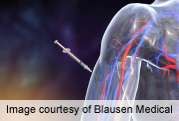For patients with type 2 diabetes, following administration of a subcutaneous injection of a therapeutic dose of insulin glargine, glargine is minimally detectable in blood, and most of the plasma insulin concentration is in the form of its metabolite M1, according to a study published online Oct. 18 in Diabetes Care.
(HealthDay)—For patients with type 2 diabetes, following administration of a subcutaneous injection of a therapeutic dose of insulin glargine, glargine is minimally detectable in blood, and most of the plasma insulin concentration is in the form of its metabolite M1, according to a study published online Oct. 18 in Diabetes Care.
To examine the concentration of plasma insulin glargine and its metabolites after subcutaneous dosing, Paola Lucidi, M.D., Ph.D., from the University of Perugia in Italy, and colleagues performed a 32-hour euglycemic glucose clamp study (0.4 units/kg glargine after one week of daily glargine administration) in nine patients with type 2 diabetes. A liquid chromatography-tandem mass spectrometry assay was used to measure glargine, M1, and M2.
The researchers found that, in five out of nine patients, glargine was detected at negligible concentrations and at few time points. M1 exhibited the same pattern as traditional radioimmunoassay-measured plasma insulin and was detected in all patients. There was no detection of M2 at all.
"In conclusion, after subcutaneous injection of a therapeutic dose in glargine-treated type 2 diabetic subjects, glargine is only transiently, and at minimal concentration, detectable in plasma, whereas its metabolite M1 accounts for most (>90 percent) of the plasma insulin concentration," the authors write. "Thus, in vivo, glargine does not exert its long-acting metabolic effects directly as glargine but predominantly via its main metabolite M1."
Several authors disclosed financial ties to pharmaceutical companies, including sanofi-aventis, which funded the study.
More information:
Abstract
Full Text (subscription or payment may be required)
Journal information: Diabetes Care
Copyright © 2012 HealthDay. All rights reserved.


















